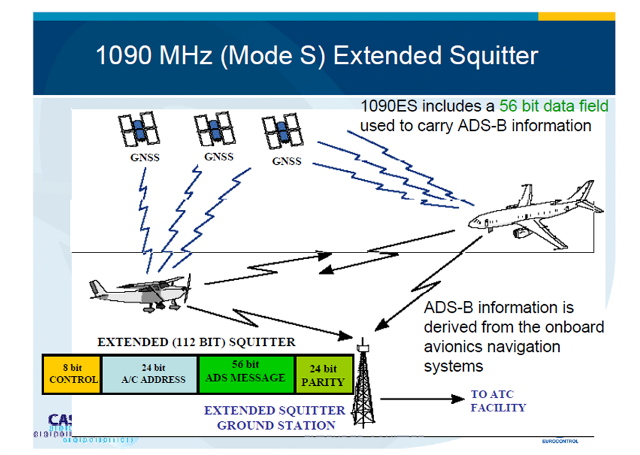Introduction to ADSL (ADS-B)
The 11th ICAO Air Transport Conference held in 2003 recommended that some countries recognize ADS-B surveillance technology as the key to improving air capacity and safety in air traffic management. With its easy-to-deploy, low-cost capabilities, ADS-B allows for increased coverage of radar surveillance coverage and additional aviation monitoring at low altitudes, local airports and areas. on the sea.
Operating principle
ADS-B is a surveillance system in which the aircraft / vehicle determines its location based on information from positioning systems (usually GPS). Location information includes location coordinates and quality metrics of location information (NUC or NIC, NAC, SIL) that are broadcast periodically and other information about the aircraft. This information can be collected by ADS-B stations used for air traffic control purposes or collected by other aircraft to help the pilot identify air traffic situations and separate them.

ADS-B stands for:
- Automatic: This means that the pilot does not have to enter data (except for the pilot's transmitter).
Dependent: means that the location information of the aircraft depends on the availability and accuracy of the navigation sources (eg GPS). This is different from standalone monitoring systems (target location is determined by the ground equipment based on the feedback signal from the target) such as the radar system.
Surveillance means the system that provides the aircraft's surveillance data such as location, altitude, velocity, and other monitoring data.
- Broadcast: This means that broadcast information is broadcast in a given period and can be captured simultaneously by all appropriate equipment such as ADS-B on the ground or on other aircraft on the site. ADS-B IN.
Component, ADS-B system standard
The ADS-B system includes:
ADS-B OUT device of the aircraft or vehicle in the airport.
Earth station equipment.
Connect.
According to connection standards, there are now three ADS-B standards:
ADS-B 1090 ES: Broadcast data on 1090 MHz Mode S expansion. This standard is used globally.
978 MHz UAT (Universal access transceiver). This standard is used in the US and Korea at FL180 flight levels.
VDL-4 (VHF Digital Link Mode 4). This standard was studied in Russia and Northern Europe.
Currently, the APAOPIRG Asia Pacific Planning and Implementation Team (APANPIRG) has decided to select the ADS-B 1090 ES as the ADS-B data link standard for Asia and the Pacific. .
In order to ensure interoperability between aircraft and ground stations, equipment on board aircraft / vehicles must meet RTCA-DO260 (version 0), RTCA-DO260A (version 1) or RTCA -DO260B (version 2).
ADS-B Information:
The ADS-B 1090 ES automatic ADS-B 1090 ES broadcast transponder is structured as follows:

The meaning of information fields is as follows:
- DF (Downlink Format) = in case of ADS-B is 17.
- CA: Transponder capability (100 = ground means; 101 = aircraft).
- AA: 24bit address of the aircraft / vehicle.
- PI (Parity Interrogator Identifier).
- ME: 56-bit aircraft / instrument code information.
The ME field is the ADS-B data field that may include the following information:
Location information (latitude, longitude, altitude and atmospheric altitude, integrity, location accuracy): 0.2s / 0.5s cycle.
Call sign: update cycle 15s / air cycle 5s, ground 10s.
Track angle and ground speed, vertical velocity (landing / landing velocity): 1.3s / 0.5s rotation cycle.
Additional information also includes: aircraft status (including emergency situations when emergency codes are selected); Identifies the special location when the IDENT button is selected.
ADS-B data from the aircraft / vehicle is collected and decoded by the ADS-B ground station, then packaged in ASTERIX CAT 21 standard and sent to the monitoring data processing center for Grant information for air traffic control.
In order to provide KSVKL with a continuous, homogeneous airway picture, ICAO recommends that countries should process ADS-B data integration along with other monitoring data sources (such as radar).
Comparative evaluation of ADS-B with ICAO secondary radar
Comparing the technical features of ADS-B with standard single-pulse radar standard, the ICAO Aviation Safety Committee and the ICAO Separator have concluded that ADS-B is better or at least comparable to the standard secondary radar. And ADS-B can be used to provide the minimum separation as described in PANS-ATM (Doc 4444). Evaluation results are detailed in ICAO Circular 326 AN / 188 "Assessment of ADS-B and Multilateration Surveillance to Support Air Traffic Services and Guidelines for Implementation".




















